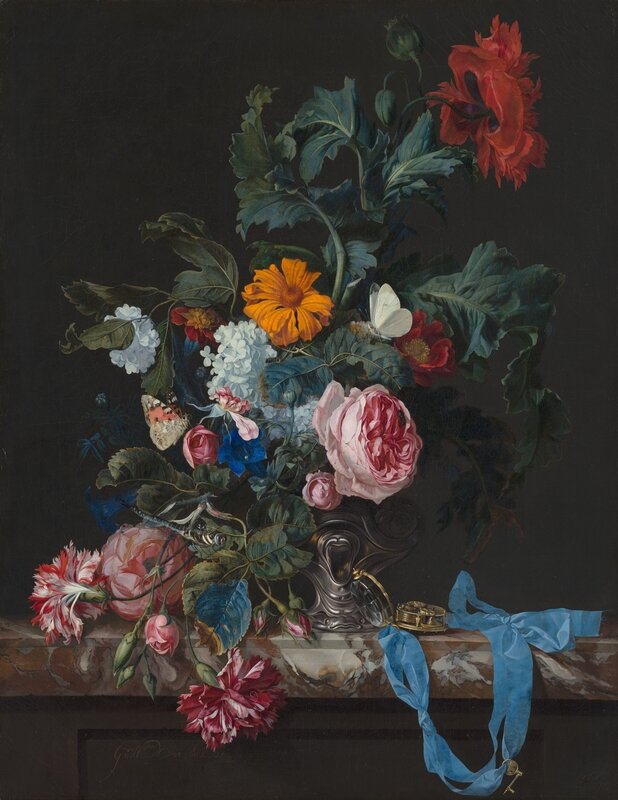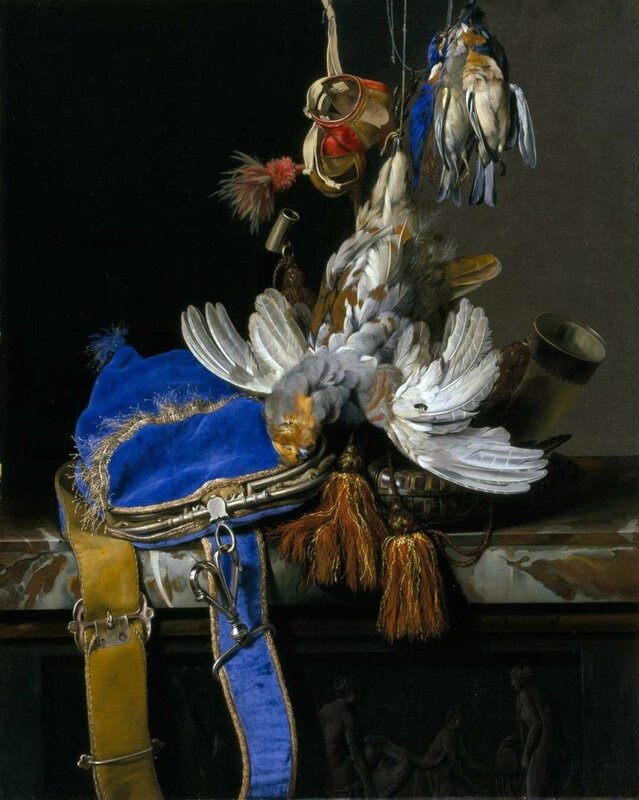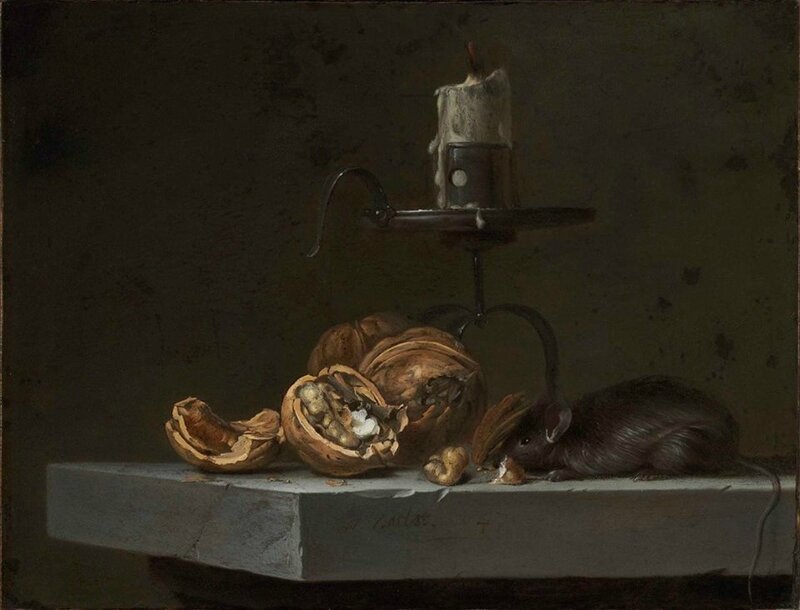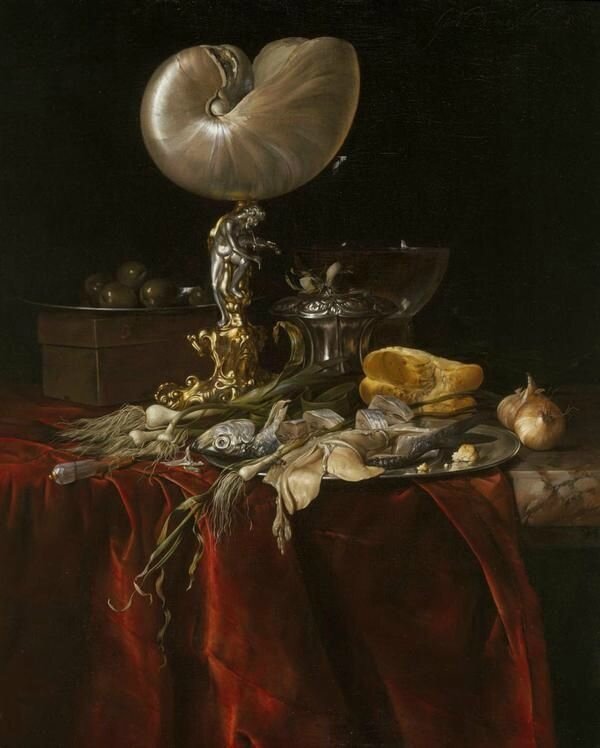"Elegance and Refinement: The Still-Life Paintings of Willem van Aelst" @ Museum of Fine Arts, Houston
Willem van Aelst, (Dutch, 1627–after 1687), Flower Still Life with a Watch, 1663. Oil on canvas. Mauritshuis, The Hague.
HOUSTON, TX.- The first-ever monographic exhibition of Dutch still-life painter Willem van Aelst (1627-1683) premieres at the Museum of Fine Arts, Houston, March 11–May 28, 2012. Co-organized by the MFAH, the National Gallery of Art, Washington, and the Sarah Campbell Blaffer Foundation, Elegance and Refinement: The Still-Life Paintings of Willem van Aelst features 28 of the artist’s finest works culled from private and public collections in the United States and Europe. Recognized as one of the leading painters in the Dutch Republic during the “Golden Age” of Dutch painting, he was largely forgotten by the 19th century. The exhibition aims to restore Van Aelst’s stature by showcasing his technical brilliance, attention to detail and ingenious brushwork for 21st-century audiences to discover.
“Van Aelst’s luxuriant compositions, rich in detail, bring to life the elegant tabletop settings of the 17th century. Over two dozen of his detailed, vibrant paintings will be on view, filled with sumptuous fabrics, elegant stone tables, ripe fruit, artfully arranged hunting trophies and brilliant platters, cups, watches, armor and more,” said James Clifton, Director of the Sarah Campbell Blaffer Foundation and Curator of Renaissance and Baroque Painting at the MFAH. “Also on view will be a large-scale painting, long credited to artist Willem Kalf, which was recently reattributed to Van Aelst during a technical examination by a National Gallery of Art conservation scientist. Within the exhibition, the painting will be rightly reunited with other works from the artist’s oeuvre.”
Elegance and Refinement is co-curated by Clifton and Arthur Wheelock, Curator of Northern Baroque Painting at the National Gallery of Art. The project was conceived by Tanya Paul, Ruth G. Hardman Curator of European Art at the Philbrook Museum of Art in Tulsa, following her Ph.D. dissertation on the artist and was developed while she was a curatorial fellow at the Sarah Campbell Blaffer Foundation in Houston. Following Houston, the exhibition will be presented at the National Gallery of Art June 24–October 14, 2012. A hardcover, illustrated catalogue of the same title, published by Skira Rizzoli in association with the MFAH, accompanies the exhibition. It is the first book dedicated solely to Van Aelst’s oeuvre and contains essays by Clifton, Wheelock, Paul and Julie Berger Hochstrasser, as well as an essay by conservators and conservation scientists, Melanie Gifford, Anikó Bezur, Andrea Guidi di Bagno and Lisha Deming Glinsman.
The paintings in the exhibition cover the range of the artist’s career and are culled from collections including the Sarah Campbell Blaffer Foundation (permanently on view at the MFAH) and the National Gallery of Art. Five paintings will be on loan from the Galleria Palatina at the Palazzo Pitti in Florence, which holds the largest concentration of Van Aelst’s work since it was collected extensively by the Medici court and later transferred to state collections. Others works have been lent by the Staatliche Museen zu Berlin; The Fitzwilliam Museum, Cambridge; Liechtenstein Museum, Vienna; Mauritshuis, The Hague; and The Fine Arts Museums of San Francisco.
Dutch artists tended to specialize in specific areas (with Rembrandt being an unusual exception to this rule), and Van Aelst focused on two basic pronk (display) subjects: game still lifes and fruit and flower still lifes. The oil paintings were intended to convey the aura of patrician life and were often executed for wealthy patrons. The exhibition will feature a range of the artist’s best pronk paintings, lush with imported fruits; luxurious, elaborate silver-gilt objects; beautiful floral displays; and “hunting trophies” such as dead fowl, hares and other animals. Van Aelst’s works often feature marble tabletops with stone relief designs on the support. Three of the game pieces in the exhibition depict the story of the goddess Diana and her nymphs bathing. The subject was particularly appropriate for hunting images because, according to the ancient story, the hunter Actaeon stumbled into Diana’s sacred grove, and she cursed him for seeing her naked - she turned him into a stag and he was torn to pieces by his own dogs. Van Aelst’s depiction of Diana’s bath derived from a composition by the goldsmith Paulus van Vianen, and his version of the subject on a silver plaquette will be exhibited with the paintings.
The centerpiece of the exhibition will be two large-scale paintings, each measuring over six feet high and painted during Van Aelst’s sojourn in Italy, featuring unusual subject matter geared toward pleasing his patrons. Pronk Still Life with Fruit and Game (1654) was painted for Cardinal Leopoldo de’ Medici. It includes an abundance of opulent objects overflowing the canvas, including a nautilus cup on a stone table with a rich blue tablecloth, likely painted using expensive ultramarine pigment made from lapis lazuli (a stone prized in the Medici collections). The cup and pitcher in the painting allude to Medici collection objects: the hunting bag, rifle, crossbow and dead birds refer to Leopoldo’s hunting hobby; and the violin and bow allude to the patron’s love of music. The five senses are also evoked through the depictions of fruit for smell and taste; velvet and bird feathers for touch; a violin for sound; and luxury objects for sight. A centrally located, open pocket watch may have been intended to reference time or even the timelessness of the painting and shows off Van Aelst’s meticulous attention to detail and ability to create a finely finished surface.
The reattributed work, Pronk Still Life of Armor from around 1651, depicts rich fabrics and luxury metalwork objects mingled with arms and armor, all artfully scattered over a stone table and velvet upholstered chair. The painting has long been attributed to Rotterdam master Willem Kalf, but a new technical examination carried out for this exhibition and catalogue by a National Gallery of Art conservation scientist has confirmed that it is, in fact, a work by Van Aelst. Although the armor is an atypical subject for the artist, the painting is full of trademark Van Aelst flourishes: an excess of fringed decoration, rich colors typical of the Paris compositions, highlights suggested with dabbled paint and even a previously overlooked partial monogram on a medal with the letters “VA.” This work is the artist’s most complex from the Paris period and was likely commissioned by René II de Froulay, Comte de Tessé, with the weapons an indicator of the Comte’s military career.
Willem van Aelst, Still Life with Fruit, Walnuts, and Insects on a Marble Ledge, 1670, oil on canvas, private collection
Willem van Aelst, Fruit Still Life with a Mouse, 1674, oil on canvas, private collection, Boston.
Willem van Aelst, Peaches, Grapes, and a Plum on a Ledge, 1646, oil on copper, private collection.
Willem van Aelst, Hunt Still Life with a Velvet Bag on a Marble Ledge, c. 1665, oil on canvas, Sarah Campbell Blaffer Foundation, Houston.
Willem van Aelst, Still Life with a Mouse and a Candle, 1647, oil on copper, Rose-Marie and Eijk van Otterloo Collection.
Willem van Aelst, Still Life with Fish, Bread, and a Nautilus Cup, 1678, oil on canvas, private collection, Germany.

/https%3A%2F%2Fprofilepics.canalblog.com%2Fprofilepics%2F1%2F0%2F100183.jpg)
/https%3A%2F%2Fstorage.canalblog.com%2F03%2F02%2F119589%2F96711876_o.jpg)
/https%3A%2F%2Fstorage.canalblog.com%2F11%2F31%2F119589%2F94773502_o.jpg)
/https%3A%2F%2Fstorage.canalblog.com%2F20%2F83%2F119589%2F94772815_o.jpg)
/https%3A%2F%2Fstorage.canalblog.com%2F26%2F72%2F119589%2F75604929_o.jpg)
/https%3A%2F%2Fstorage.canalblog.com%2F59%2F60%2F119589%2F26458628_o.jpg)









/http%3A%2F%2Fstorage.canalblog.com%2F71%2F04%2F119589%2F128382558_o.jpg)
/http%3A%2F%2Fstorage.canalblog.com%2F74%2F59%2F119589%2F112476490_o.jpg)
/http%3A%2F%2Fstorage.canalblog.com%2F59%2F09%2F119589%2F92661276_o.jpg)
/http%3A%2F%2Fstorage.canalblog.com%2F92%2F84%2F119589%2F92142881_o.jpg)